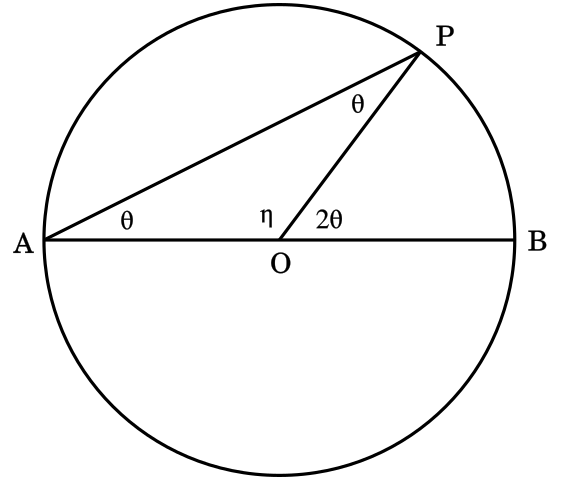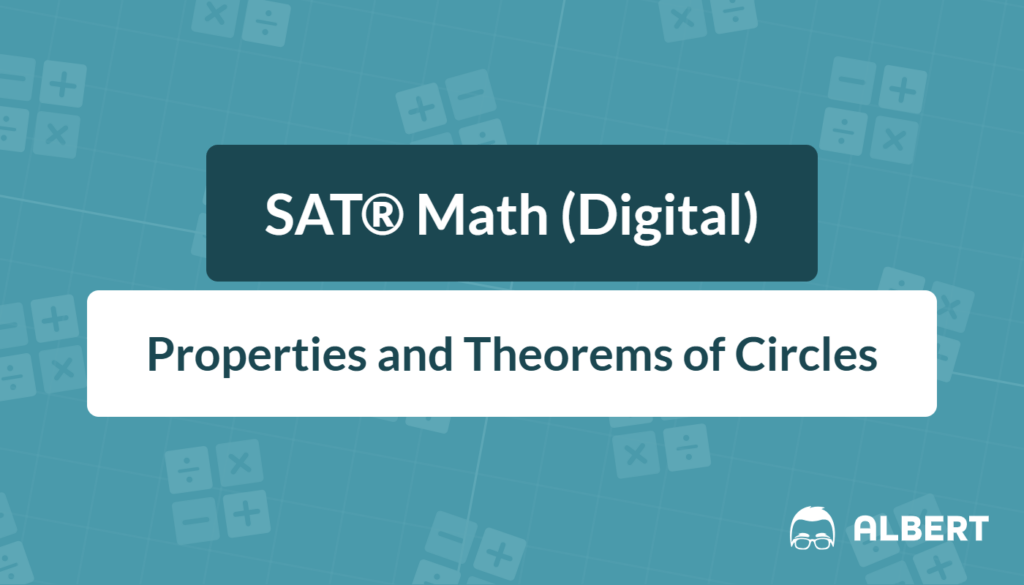What We Review
Introduction
Circles are SAT® Math all-stars. They slip into area questions, hide in tricky angle puzzles, and even power coordinate-geometry equations. Because they appear so often, mastering circle theorems and facts saves valuable test-day minutes. This guide delivers every key property and theorem in one place. By the end, you will be able to glance at any circle problem and know exactly which circle theorem to use.
Know the Parts: Basic Circle Theorem Vocabulary
Before any theorems, secure the “who’s who” of a circle.
- Center – fixed middle point
- Radius – segment from the center to any point on the circle
- Diameter – two radii back-to-back, passing through the center
- Chord – any segment whose endpoints lie on the circle
- Arc – a slice of the circumference
- Sector – “pizza slice” region bounded by two radii and their arc
- Secant – a line intersecting the circle at two points
- Tangent – a line touching the circle at exactly one point (the point of tangency)
Example 1
Given a circle with a diameter of 14 cm, find the radius, circumference, and area.
Solution
- Identify the radius.
- r = \frac{\text{diameter}}{2} = \frac{14}{2} = 7\text{ cm}
- Find the circumference.
- C = 2\pi r = 2\pi(7) = 14\pi\text{ cm}
- Find the area.
- A = \pi r^{2} = \pi(7)^{2} = 49\pi\text{ cm}^{2}
Circle Theorems: Angle–Arc Relationships
Understanding how angles connect to arcs is central to the SAT®.
A. Central Angle Theorem
The central angle measure equals its intercepted arc measure. Therefore, if a central angle is 50^{\circ}, its arc is also 50^{\circ}.
B. Inscribed Angle Theorem
An inscribed angle (vertex on the circle) is half its intercepted arc. Hence, an inscribed angle of 30^{\circ} cuts off a 60^{\circ} arc.

C. Angles Formed by Chords, Secants, and Tangents
- Chord–Chord angle (inside the circle): m\angle = \tfrac{1}{2}(\text{arc}_1 + \text{arc}_2)
- Secant–Secant or Secant–Tangent (outside): m\angle = \tfrac{1}{2}(\text{far arc} - \text{near arc})
- Tangent–Tangent (outside): same subtraction rule.
Example 2
In the figure, chords \overline{AC} and \overline{BD} intersect at E inside the circle. The measure of arc AD = 80^{\circ} and the measure of arc BC = 100^{\circ}. Find m\angle AED.
Solution
- Chord–Chord formula applies.
- m\angle AED = \tfrac{1}{2}(80^{\circ}+100^{\circ})
- Calculate.
- m\angle AED = \tfrac{1}{2}(180^{\circ}) = 90^{\circ}
Circle Theorems: Arc Length & Sector Area
Test writers love “partial-circle” questions. Formulas appear in the SAT® reference sheet, but knowing how to pick the right one is faster.
- Arc length (degrees): \text{Length} = \frac{\theta}{360^{\circ}},2\pi r
- Arc length (radians): \text{Length} = r\theta
- Sector area (degrees): \text{Area} = \frac{\theta}{360^{\circ}}\pi r^{2}
- Sector area (radians): \text{Area} = \tfrac{1}{2}r^{2}\theta
Radian refresher: 180^{\circ} = \pi\ \text{radians}. Therefore, multiply degrees by \tfrac{\pi}{180} to convert.
Example 3
In a 60^{\circ} sector of a circle with r = 8, find (a) arc length and (b) sector area.
Solution
- Arc length:
- \text{Length} = \frac{60^{\circ}}{360^{\circ}},2\pi(8) = \frac{1}{6},16\pi = \tfrac{16\pi}{6} = \tfrac{8\pi}{3}\text{ units}
- Sector area:
- \text{Area} = \frac{60^{\circ}}{360^{\circ}}\pi(8)^{2} = \frac{1}{6},64\pi = \frac{64\pi}{6}= \tfrac{32\pi}{3}\text{ sq units}
The Coordinate Circle: Equations and Graphs
The SAT® blends geometry and algebra through circle equations.
A. Standard Form
x-h^{2} + (y-k)^{2} = r^{2}Every point (x, y) on the circle is exactly r units from (h, k)—a direct application of the distance formula.
B. General Form → Completing the Square
An equation may appear expanded: x^{2}+y^{2}+Dx+Ey+F=0. Completing the square twice reveals the center and the radius.
C. Creating an Equation
- Given a center of (2, –5) and a radius of 4: x-2^{2} + (y+5)^{2} = 16.
- Given three points, use distance or algebra to solve for h, k, r.
Example 4
Convert x^{2}+y^{2}-4x+6y-12=0 to standard form, then state the center and radius.
Solution
- Group the x’s and y’s:
- (x^2-4x)+;(y^{2}+6y)=12
- Complete squares.
- For x: half of –4 is –2, square → 4.
- For y: half of 6 is 3, square → 9.
- Add 4 and 9 to both sides:
- (x^2-4x+4)+ (y^{2}+6y+9) = 12+4+9
- Rewrite as binomials.
- x-2^{2} + (y+3)^{2} = 25
- Center = (2, –3) Radius = 5
Graph Shifts & Radius Changes
Shifts are simple once the pattern is clear.
- The (h, k) in x-h^{2}+(y-k)^{2}=r^{2} moves the circle right h and up k.
- Increasing r stretches the circle; decreasing r squeezes it.
Mini-Example
Compare (x+3)^{2}+(y-1)^{2}=25 with x^{2}+y^{2}=9.
Solution
- Center moves left 3 and up 1 (from (0, 0) to (–3, 1)).
- Radius increases from 3 to 5, so the new circle is larger.
Unit Circle & Trig Tie-In
The unit circle (radius 1, center at the origin) links geometry and trigonometry.
- Key radians: 0, \tfrac{\pi}{6}, \tfrac{\pi}{4}, \tfrac{\pi}{3}, \tfrac{\pi}{2}, etc.
- Coordinates: point at angle θ has (\cos θ, \sin θ). Therefore, cosine is the x-coordinate, sine is the y-coordinate, and tangent = \tfrac{\sin\theta}{\cos\theta}.
Example 5
Find \sin 135^\circ, \cos 135^\circ, \tan 135^\circ, and convert 135^\circ to radians.
Solution
- Convert: 135^{\circ}\times\frac{\pi}{180^{\circ}}=\tfrac{3\pi}{4}.
- Unit-circle coordinates at \tfrac{3\pi}{4} are \left(-\tfrac{\sqrt{2}}{2},\tfrac{\sqrt{2}}{2}\right).
- \sin 135^\circ = \tfrac{\sqrt{2}}{2}
- \cos 135^\circ = -\tfrac{\sqrt{2}}{2}
- \tan 135^\circ = –1
Mixed SAT®-Style Practice
- A circle centered at (–2, 4) has a radius of 6. A tangent at point T touches the circle where T’s x-coordinate is 2. Find the slope of the tangent line.
- \overline{AB} is a diameter of length 10. Point C lies on the circle so that arc AC measures 120^{\circ}. Find the approximate length of the chord AC.
Solution
- –4
- AC ≈ 8.66
Quick-Reference Vocabulary Chart
| Term | Definition | SAT® Tip |
| Radius | Segment from the center to the circle | Often half a given diameter; use in every formula |
| Diameter | Longest chord, passes through center, equals 2r | Identifying a diameter reveals right angles with a third point |
| Chord | Any segment with both endpoints on a circle | If two chords intersect, their products are equal |
| Arc | Portion of circumference measured in degrees or radians | Arc measure often equals a central angle |
| Sector | Region bounded by two radii and their arc | Think “pizza slice” for area problems |
| Tangent | Line touching circle at exactly one point | Tangent is perpendicular to the radius at the contact point |
| Secant | Line cutting the circle twice | Use secant-secant theorem for external angles |
Final Takeaways & Common Pitfalls
- Always match the correct angle-arc theorem—mix-ups cost points.
- Convert degrees to radians before applying s=r\theta.
- Look for hidden right triangles; diameters often create them.
Practice these properties and theorems of circles until they feel automatic. Future SAT® Math questions will then feel like smooth sailing.
Master these steps, and circle questions will quickly roll in your favor!
Sharpen Your Skills for SAT® Math (Digital)
Are you preparing for the SAT® Math (Digital) test? We’ve got you covered! Try our review articles designed to help you confidently tackle real-world SAT® Math (Digital) problems. You’ll find everything you need to succeed, from quick tips to detailed strategies. Start exploring now!
Need help preparing for your SAT® Math (Digital) exam?
Albert has hundreds of SAT® Math (Digital) practice questions, free response, and full-length practice tests to try out.









